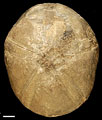The Echinoid Directory
Contributed by Jenna Sullivan, May 2007
Oviclypeus Dames, 1877, p. 44
| Diagnostic Features |
|
|---|---|
| Distribution | Eocene, Italy and Slovenia |
| Name gender | masculine |
| Type | Oviclypeus lorioli Dames, 1877, p. 45, by monotypy. |
| Species Included | O. lorioli Dames, 1877; Eocene, San Giovanni Ilarione, Italy. |
| Classification and/or Status | Irregularia; stem group Clypeasteroida; Conoclypidae. Junior subjective synonym of Conoclypus. |
| Remarks | There is little that distinguishes this taxon from Conoclypus, apart from its characteristic elongated form, which is interpreted as species-specific character here. [Comment provided by Andreas Kroh 02/2010] Dames, W. 1877 (November). Die Echiniden des Vicentinischen und Veronesischen Tertiaerablangerungen. Palaeontographica 25, 1-100, pls 1-11. |





